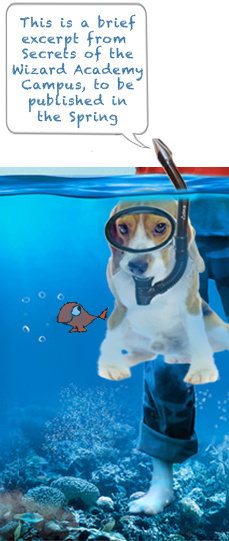On the campus of Wizard Academy, we travel upward to study and celebrate, downward to find meaning and rest.
According to Carl Jung’s theory of depth psychology7, life is a journey on water.
Water: that transparent portal separating the objective reality of the conscious mind from the subjective reality of the unconscious mind. Above the waterline is that hectic world of our conscious mind, filled with all the difficulties of daily life, that place of hot sunlight and traffic, bees and business, trees and trouble.
Below the waterline is the unconscious mind, a silent world, a beautiful world where we feel weightless and anything is possible.
Our relationship to the unconscious mind is exactly like our relationship to water. We need it by the cupful to survive; but if we stay down too long, we risk a psychotic break; yes, there are monsters in the deep. But a brief plunge into the waters of the unconscious is stimulating. We are refreshed each time we submerge ourselves into “the arts.”
The arts communicate to the unconscious mind through:
- the visual languages of color, motion, shape, proximity, and radiance,
- the abstract languages of symbol and simile and metaphor, and
- the auditory languages of pitch, key, tempo, contour, interval, rhythm, and phonemes.
Waterlines – both real and implied – are important symbols on the campus of Wizard Academy. We will examine a few of these waterlines throughout the book.9
7 cgjungcenter.org tells us that depth psychology includes “therapeutic traditions that explore the unconscious and involve the study and exploration of dreams, complexes, and archetypes. Depth psychology is non-pathologizing and strength affirming.”
8 In Jungian depth psychology, the animus is the perfect man that lives in the mind of a woman, and the anima is the perfect woman that lives in the mind of a man. The four faces of the animus are the masculine archetypes: King, Healer, Warrior, and Wizard. The four faces of the anima are the feminine archetypes: Mother (Eve,) Lover (Helen of Troy,) Strong Woman (Mary, mother of Jesus) and Mystic (Sophia, a man’s guide to his inner life.) Perfectly aligned at the terminus points of the lower path to the tower, The Old Man and the Sea and Into the Wind speak of the Warrior and the Strong Woman archetypes.
9 Additional waterlines are discussed in Chap. 2 “The Laughlin Stone,” Chap. 7 “The Fountain at Engelbrecht House,” and Chap. 10 “Tuscan Hall.”
We’ll examine the first waterline by approaching the tower from the south.
Do you see The Thinker at the edge of the parking lot?
Follow that sidewalk and you’ll find:
The Old Man and the Sea, by Jane DeDecker…
